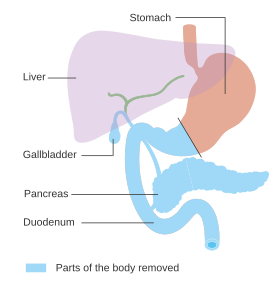| This article needs additional citations for verification. Please help improve this article by adding citations to reliable sources. Unsourced material may be challenged and removed. Find sources: "Pancreatectomy" – news · newspapers · books · scholar · JSTOR (January 2016) (Learn how and when to remove this message) |
| Pancreatectomy | |
|---|---|
 Diagram showing the area removed for a total pancreatectomy Diagram showing the area removed for a total pancreatectomy | |
| ICD-9-CM | 52.5-52.6 |
| MeSH | D010180 |
| OPS-301 code | 5-524-5-525 |
| [edit on Wikidata] | |
In medicine, a pancreatectomy is the surgical removal of all or part of the pancreas. Several types of pancreatectomy exist, including pancreaticoduodenectomy (Whipple procedure), distal pancreatectomy, segmental pancreatectomy, and total pancreatectomy. In total pancreatectomy, the gallbladder, distal stomach, a portion of the small intestine, associated lymph nodes and in certain cases the spleen are removed in addition to the entire pancreas. In recent years, the TP-IAT (Total Pancreatectomy with Islet Autotransplantation) has also gained respectable traction within the medical community. These procedures are used in the management of several conditions involving the pancreas, such as benign pancreatic tumors, pancreatic cancer, and pancreatitis.
Indications
It is performed for a variety of reasons, including:
- Inflammation
- Necrotising pancreatitis
- Chronic pancreatitis with pain
- Trauma
- Neoplasms
- Adenocarcinoma (85%)
- Cystadenoma (mucinous/serous)
- Cystadenocarcinoma
- Islet cell tumors (neuroendocrine tumors)
- Papillary cystic neoplasms
- Lymphoma
- Acinar cell tumors
- Severe hyperinsulinemic hypoglycemia
Types
| This section does not cite any sources. Please help improve this section by adding citations to reliable sources. Unsourced material may be challenged and removed. (October 2024) (Learn how and when to remove this message) |
The most common surgical procedure involving removal of a portion of the pancreas is called a pancreaticoduodenectomy.

Among common consequences of complete or nearly complete pancreatectomy are deficiencies of pancreatic endocrine or exocrine function requiring replacement of insulin or digestive enzymes. The patient immediately develops type 1 diabetes, with little hope for future type 1 diabetes treatments involving the restoration of endocrine function to a damaged pancreas, since the pancreas is either partially or completely absent. Type 1 diabetes can be treated with careful blood glucose monitoring and insulin therapy. Because the pancreas is responsible for the production of many digestive enzymes, a pancreatectomy should only be given as an option for pancreatic disease which is life-threatening, such as pancreatic cancers. Even after a pancreatectomy, pain still exists in most patients.
A distal pancreatectomy is removal of the body and tail of the pancreas.
Prognosis
After a total pancreatectomy, the body no longer produces its own insulin or pancreatic enzymes, so patients have to take insulin and enzyme supplements. Those who were not already diabetic become so. Glycemic control is challenging even for relatively young and healthy apancreatic people, owing to the digestive challenges of not having endogenous insulin and pancreatic enzymes under autonomic control. It can be insurmountably challenging depending on age and comorbidities. But overall, quality of life in patients after total pancreatectomy is comparable with quality of life in patients who undergo a partial pancreatic resection.
An experimental procedure called islet cell transplantation, most frequently the autotransplantation of islets isolated from the explanted pancreas into the portal vein, exists to help mitigate the loss of endocrine function following total pancreatectomy.
See also
References
- "Pancreatectomy Surgery (Removal of the Pancreas)". The Pancreas Center of Columbia University. Retrieved 22 May 2024.
- McEachron, Kendall R.; Bellin, Melena D. (September 2018). "Total pancreatectomy and islet autotransplantion for chronic and recurrent acute pancreatitis". Current Opinion in Gastroenterology. 34 (5): 367–373. doi:10.1097/MOG.0000000000000458. ISSN 0267-1379. PMC 9623823. PMID 29901515. S2CID 49191052.
- Golden, Megan (2019-04-30). "Will Pancreas Surgery Cure My Pancreatitis? Doctors Explain TPIAT". Mission: Cure. Retrieved 2020-02-29.
- Epelboym, I; et al. (2014), "Quality of life in patients after total pancreatectomy is comparable with quality of life in patients who undergo a partial pancreatic resection", Journal of Surgical Research, 187 (1): 189–196, doi:10.1016/j.jss.2013.10.004, PMID 24411300.
- Shindo Y, Kanak MA (2017). Levy MF (ed.). "Total pancreatectomy with islet autotransplantation: recent updates and outcomes". Current Opinion in Organ Transplantation. 22 (5): 444–451. doi:10.1097/MOT.0000000000000451. PMID 28719390.
- Khazaaleh S, Babar S, Alomari M, Imam Z, Chadalavada P, Gonzalez AJ, El Kurdi B (2023). "Outcomes of total pancreatectomy with islet autotransplantation: A systematic review and meta-analysis". World Journal of Transplantation. 13 (1): 10–24. doi:10.5500/wjt.v13.i1.10. PMC 9850868. PMID 36687559.